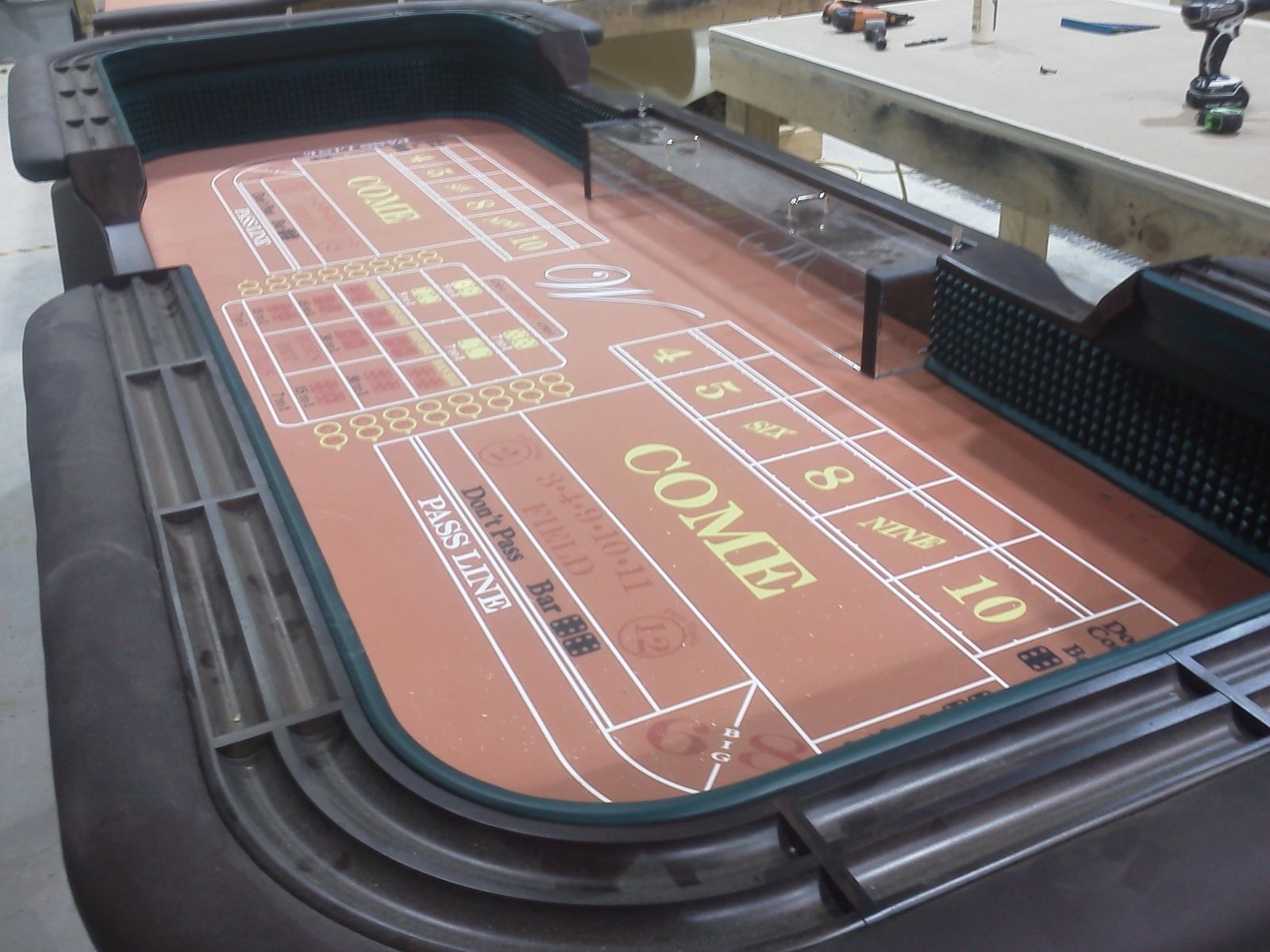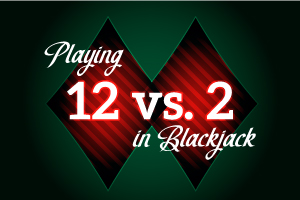12 In Blackjack
A Python repl by sekhar12in. Double Down Blackjack Rules. The rules of doubling down can vary from casino to casino. It is always best for you to know the house rules regarding a double down before you sit down to play blackjack. Today, in most casinos, a player is allowed to double down on any two original cards. You can even double down a blackjack in some casinos. « Blackjack Hand 12 or 13 Surrender Rule » If players’ priority is to win and to improve with every single blackjack game, then they need to put effort and time into achieving it. There are many other things that gamblers need to take into account and focus on prior to playing and during the game. A-A is a soft 12 and can be doubled in very rare circumstances. It is most often split, however. A-8 and A-9 are technically soft hands but they are never considered as such in basic blackjack strategy. This is because the totals of these hands are 19 and 20, respectively, and you should always stand on them. You're playing in a four-deck game, and receive a 3 and a 9 for a two-card total of 12, while the dealer flips an upcard of 4. You have a tough decision here, but basically, it's a choice between hitting the 12 or standing on the hand. Which option do you choose?
Many gamblers who play blackjack on a regular basis don’t take the time to have a look at every possible total value they can get in their hand. There are indeed so many cards that can form a number of combinations, especially if the decks in use are more than one.
However, if players want to master the game and make the best possible choices every time, it is crucial to know how to proceed in the most difficult situations. They need to dedicate their time and determine their goals if they need to achieve the desired results. Gamblers, who claim that they like to play just because of the thrill, fail to understand that blackjack can be not only fun but also profitable.
In this chapter, we will have a look at the two particular hands 12 or 13 players can get during the course of the game. As already mentioned, the reason why it is important for gamblers to be familiar with absolutely every hand they can get is that knowing the possible outcomes of it can help them make wiser choices. Even though one hand doesn’t determine the overall result of the game, it is very essential to try and do your best every time.
When Players Have Hand 12
Regardless of the strategy players use, they always need to take into account their hand’s total value and the dealer’s upcard. Players can form such a hand with the following combinations: 2-10, 3-9, 2-8, 5-7, A-A, and 6-6. In order to find out what is the best possible choice they can make, let’s consider the case where gamblers have a hand 12 against every possible upcard of the dealer.
Both hard 12 and hard 13 are losing hands for the player. How they are played depends on the strength of the dealer’s exposed card. The stronger the upcard, the more aggressive approach players should adopt and vice versa.
With hard 12, you have a choice from splitting when you hold 6-6 and A-A, and hitting and standing with the other card combinations that lead to this hard total. Doubling is out of the equation because it is anything but a good move with hard 12.
The good news for blackjack rookies is that the optimal playing strategy for unpaired hard 12 (i.e. any hand that does not contain two cards of the same value) is not influenced by playing conditions and deck number. The correct moves coincide across all blackjack variations, including European games that lack hole cards.
If the dealer’s upcard is 4, 5, or 6, gamblers should stand. If the dealer has any other card, gamblers should hit. The logic behind standing when the dealer shows 4 through 6 is that these upcards result in very high bust rates for the dealer. Unlike players who can decline additional cards on any total they deem fit, the dealer must hit until they reach their standing position of 17 or greater. This puts the dealer in a volatile position, increasing their probability of a bust.
Small cards 4 through 6 are the worst for the dealer as they bring the highest bust percentages. Assuming the dealer has peeked under their hole card and does not have a blackjack, their probability of busting with a 4 in a standard six-deck S17 game stands at 0.395805, or roughly 39.6% of the time.
Should You Hit On A 12 In Blackjack
The dealer probabilities of busting with a 5 and a 6 are even higher at 0.418406 (41.8%) and 0.422842 (42.3%). This is why you stand on your hard 12 versus small upcards 4 through 6, keeping your fingers crossed for a dealer bust, and hit versus the other upcards as they improve the dealer’s situation.

The position of a player who holds a hard 12 is not enviable, either. In general, hard 12 through hard 16 are some of the lousiest hands you can get stuck with. These are inevitably long-term losers against most dealer upcards no matter whether you choose to stand or hit. You can see this from the figures in the table below as estimated by gambling expert Michael Shackleford.
The example is with a 12 against a weak 6 and a strong dealer 10 in a common multi-deck variant where the dealer stands on soft 17. Nevertheless, hard 12 offers poor odds to the player regardless of what upcard they are up against. It makes sense the best playing decision is the one that yields the lowest negative expectation for you.
| EV of Hitting vs. Standing on Hard 12 against Weak and Strong Dealer Upcards | |||
|---|---|---|---|
| EV of Hard 12 vs. 6 | EV of Hard 12 vs. 10 | ||
| Hitting | -0.170526 | Hitting | -0.381043 |
| Standing | -0.153699 | Standing | -0.540430 |
2 or 3 as the Dealer’s Up Card
It is worth mentioning that when the player’s hand totals 12 and the dealer’s upcard is either 2 or 3, they need to be extra cautious and remember how to proceed in this situation. In the worst-case scenario, players can draw any of the face cards or a 10 which will inevitably result in going bust.
The possibility that the players’ hand will lead to this unfortunate outcome is not very small either – four out of thirteen, or roughly 30% of the time. Players need to focus on the cards that will leave them with a power hand – a 7, an 8, or a 9. If gamblers are lucky enough to get any of them, it guarantees them a total of at least 19, which is above the average winning hand of 18.5.
Moreover, the rest of the cards in the deck won’t result in a loss for the players so the bottom line is that players are not in the worst position with hand 12. Holding hard 15 or hard 16 is far more terrible, for example.
| Hand 12 against 2 or 3 as the Dealer’s Upcard | ||
|---|---|---|
| Dealt Card | Total Score | Hand |
| 2-3 | 14-15 | A Bad Hand |
| 4-5-6 | 16-18 | An Average Hand |
| 7-8-9 | 19-21 | A Brilliant Hand |
The trouble is most novices handle hard 12 against these two dealer upcards incorrectly. One of the biggest blunders a blackjack player can make is standing on 12 versus the dealer’s deuce. This stems from the fear of drawing a high card on the hard hand, which would result in a bust and an automatic loss.
Such players frequently abide by the Rule of 10. They make their decisions based on the assumption the dealer always has a ten-value card in the hole. Respectively, the reasoning is that the dealer would flip over a ten next to their deuce, draw another high card, and bust. The player stands rather than hits their 12 out of fear they would “take the dealer’s bust card”.
Should You Hit 12 In Blackjack
Unfortunately, there is no such thing since the true odds favour hitting 12 versus 2. In reality, there are five card denominations (5 through 9) you can improve your total with versus four cards that would cause you to break your 12 with a hit (K, Q, J, and 10). The odds clearly are in favour of hitting, not standing.
Also important is the fact that the dealer is not in such a bad spot when starting with a deuce. The probability of them busting is estimated at 0.353504, or approximately 35% of the time in six-deck S17 games.
If we ignore the pushes, hitting the 12 against the deuce results in a win roughly 37% of the time and leads to a loss a little over 63% of the time. Assuming you are betting £1 on each hand, you will suffer net losses of approximately £26 every one hundred hands on average.
Meanwhile, standing on hard 12 results in a win roughly 35% of the time and leads to a loss around 65% of the time, giving you average net losses of £30 per every one hundred rounds when we ignore the pushes. It is only natural for players to prefer hitting over standing on 12 against a deuce because it reduces their long-term losses.
| EV of Hitting vs. Standing on Hard 12 against the Dealer’s Deuce | |||
|---|---|---|---|
| EV of 12 vs. 2 | EV of 12 vs. 3 | ||
| Hitting | -0.253390 | Hitting | -0.233691 |
| Standing | -0.292784 | Standing | -0.252250 |
The same tendencies and harmful reasoning are to be observed with novices who hold hard 12 against the dealer’s 3. They are too scared to hit, as basic strategy tells them to, so they choose to stand instead and lose more money in the long run. This is yet another terrible but unfortunately common bad decision.
The dealer is not as weak when starting with a 3, busting only 37.4% of the time. Basic strategy again recommends hitting in this case because this play cuts down your negative expectation, leading to lower long-term losses with your hard 12 vs. 3. The difference is minuscule, as you can see above, but things will add up over thousands of hands played.
As for hard 12 that contains 6-6 or A-A, we shall tackle these situations in more depth in individual articles. For now, it suffices to mention you should always split paired aces. The correct plays for 6-6 are influenced by playing conditions, and more particularly by the number of decks.
When Players Have Hand 13
Regardless whether players have a hand 13, 14, 15, or 16, they should use the same strategy against the dealer up card. This is very convenient as there is no need players to remember different moves when their hand totals any of the above mentioned cases. These four types of hands put player in a very risky position and it is crucial to remember how to play them best.

Now let’s focus on hand 13 in particular and see what is the best move players can make. When gamblers find themselves in a situation where their hand totals 13 and the dealer’s upcard is from 2 through 6, they should stand. For the rest of the possibilities of the dealer’s upcard, players need to hit, i.e. against stronger cards 7 through ace. There are no exceptions to these rules no matter how many decks are used. Whether the dealer must hit or stand on soft 17 is also not relevant.
Blackjack Hand 14, 15 or 16
Surrender Rule
Blackjack Soft Hand 13 to 17
Blackjack Soft Hand 18
Blackjack Soft Hand 19 or 20
The reason why players should hit in such cases is that the dealer has the so-called standing hand. The dealer has such a hand whenever they show a card from 7 through ace. This puts them in an advantageous position as all that is needed for them is to reveal their upcard. In other words, the dealer is more likely to reach their standing total of 17 or higher when starting with 7 or above.
Their probability of busting decreases proportionally to the strength of their upcard, i.e. the higher its value, the lower the odds of the dealer breaking their hand. A dealer who stands on soft 17 in six-deck games will bust roughly 26.2% of the time with a 7, 24.4% of the time with an 8, and 22.9% per every hundred hands with a 9.
The bust rates decline even further when the dealer begins with a ten-value card or an ace to 23% and 16.7%, respectively. Thus, gamblers need to remember to refrain from any aggressive moves and play cautiously if they have the already mentioned situation.
Odds and Probabilities
It is not easy to estimate in a timely manner what the odds and probabilities are when a certain situation occurs. This is why players should be prepared beforehand and know the chances a particular hand gives them and what is the best move they can make.
12 Blackjack Gloss Black

Throughout the years, many experts and mathematicians took their time to estimate the odds and probabilities of the possible different hands gamblers can get throughout the course of the game.
It is estimated that in cases when players have hand twelve their chance of going bust is 31%. Whenever they have hand thirteen, the odds of going bust increase to 38%. These odds and probabilities are based on a game which includes many decks and are true if players’ choice is to hit.
| Blackjack Players’ Odds and Probabilities | |
|---|---|
| Players’ Hand | Chances to Bust with a Hit |
| 11 or less | 0% |
| 12 | 31% |
| 13 | 38% |
| 14 | 46% |
| 15 | 54% |
| 16 | 62% |
| 17 | 69% |
| 18 | 77% |
| 19 | 85% |
| 20 | 92% |
Conclusion

It is really important for players to understand that whenever their hand totals less than 19, they are in a bad position as the average winning hand is 18.5. Even 18 doesn’t guarantee them a certain win, what is left for a hand 12 or 13.
However, having any of these two hands doesn’t doom players to a certain loss either. All that gamblers need to understand is that knowing how to proceed in a certain situation directly affects their moves and choices and determines the course of the game. This is the only way they will be able to tackle with such situations and achieve the desired result.
| Hand 12 and Hand 13 Basic Strategy Plays | ||||||||||
|---|---|---|---|---|---|---|---|---|---|---|
| Players’ Hand | Dealer’s Upcard | |||||||||
| 2 | 3 | 4 | 5 | 6 | 7 | 8 | 9 | 10 | Ace | |
| 12 | H | H | S | S | S | H | H | H | H | H |
| 13 | S | S | S | S | S | H | H | H | H | H |
Using the right strategy doesn’t guarantee players their losing hand will transform into a winning one but it gives them the chance to make a choice which will let them lose the least amount of money. If players find themselves in the situation when they have a hand 12 or 13, they need to remember when to hit and stand and follow basic strategy throughout the whole game.